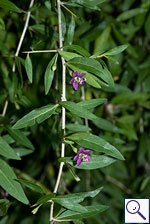|
||||||
|
LYCIUM. Teaplants. [Solanaceae] |
|
|
Two species of Lycium are recorded in Britain, the introduced Duke of Argyll's Teaplant (L. barbarum) and Chinese Teaplant (L. chinense). Thrtee British miners are recorded on Lycium. A key to the European miners recorded on Lycium is provided in Bladmineerders van Europa.
|
 Duke of Argyll's Teaplant Lycium barbarum |
Key for the identification of the known mines of British |
1a > Leaf-miner: A short, irregular, linear upper surface mine on any part of the leaf. Also recorded from young pods (Bland, 1997a). Long corridor mine. As a rule the first part of the mine is lower-surface, the later part upper-surface. Often the loops are so dense that a secondary blotch is the result. Because upper- and lower-surface corridor segments often cross, the mine obtains a strange array of transparant patches. There is no association with the midrib. Frass in strings and thread fragments. Pupation outside the mine; exit slit in upper epidermis. Mine not associated with the veins or midrib of the leaf (It is this character which enables distinction from another Agromyzid pest species - Liriomyza huidobriensis). The larvae may leave one leaf (if not large enough) and enter another leaf, via the petiole). It exits the leaf to pupate through a semi-circular slit in the upper surface of the leaf. |
|
Liriomyza bryoniae (Kaltenbach, 1858) [Diptera: Agromyzidae]. |
1b > Leaf-miner: Mine linear, whitish, both upper and lower surface. Pupation internal, at the end of the mine with the anterior spiracles projecting through the epidermis (Spencer, 1976: 433). Upper-surface, less often lower-surface corridor. Frass in isolated grains. Pupation within the mine, in a, usually lower-surface, pupal chamber. A long whitish upper surface corridor, which eventually goes lower surface. |
|
Chromatomyia
horticola (Goureau, 1851) [Diptera: Agromyzidae] |
1c > Leaf-miner: Large blotch mine, often with several larvae, beginning with a short deeper corridor at a single egg shell on the surface of the leaf. The broad deep corridor later ends in a blotch but can be recognised (beneath the blotch) by its greater depth. Mine predominantly dorsal or ventral, greenish in transmitted light. Frass grains irregularly scattered except in the initial corridor. Blotch, mostly occupying almos the entire leaf, containing several larvae. Much, half-deliquescent, greenish-black frass. At the start of the mine at the leaf underside a group of some 5 elliptic egg shells, parallel to each other. However, the larvae can leave their mine and restart elsewhere, so mines without egg shells can occur as well. The larvae do not penetrate into the stem of the plant, neither is the mine full depth (compare Delia species). Mine indistinguishable from P. exilis or P. hyoscyami. Makes a large upper surface whitish blotch, which can contain several larvae. The frass has a washed out appearance and is greenish. There may be several mines on a leaf and eventually the leaf will be mined and then shrivel up. To identify this miner adults must be reared. |
|
Pegomya hyoscyami (Panzer, 1809) [Diptera: Anthomyiidae]. |
| Last updated 05-Jul-2019 Brian Pitkin | ||
